
Today, Sam the scientist came to visit our school and share what he has seen in Antarctica, his work in Antarctica and understanding how marine ecosystems works (predators and prey in the ocean.) He studies creatures that only have one cell - we have trillions! One cell is about the size of a coin, so they range in size from microscopic to massive.
Foraminifera
Foraminifera The Foraminifera, ("Hole Bearers") or forams for short, are a large group of amoeboid protists with reticulating pseudopods, fine strands of cytoplasm that branch and merge to form a dynamic net.[1] They typically produce a test, or shell, which can have either one or multiple chambers, some becoming quite elaborate in structure.[2] About 275,000 species are recognized, both living and fossil. They are usually less than 1 mm in size, but some are much larger, and the largest recorded specimen reached 19 cm." (From Wikipedia, the free encyclopedia)
Planes land on a strip 4m thick of ice. Planes fly out of chch and fly due south to Antarctica. They can carry 2 helicopters in them and they hold about 150 people comfortably. The inside of the plane is the size of a bball court! They then catch a helicopter and travel 60km to their studies - "New Harbour".
There are about 800 people in Antarctica when they go down to do their research.
At "New Harbour", they live in 2 tents connected by a hallway. They use solar power, wind power (its very windy and noisy) and propane - so they can get electricity 3 ways. They eat a lot of pizza! New York's favourite food!
They have to dig through 4m of ice to get samples. They have 2 dive holes - one for safety. This past year it was 6m! They use a giant drill and first they dig a small hole then they fill it with dynamite, then they stand back and make a big hole! When the dynamite explodes it explodes outwards shattering the ice. Because water can't compress it goes outwards into the ice then upwards. They end up with a big slush pit which they have to dig out. One diver has to go down and check whether the hole goes all the way down then chip away. It takes hours!
Its completely dark under the ice as the sunlight can't penetrate the thickness of the ice. Divers have to carry flashlights. It is easy to find your way out as you swim towards the light. They wear lots of layers of clothes and the only part of your body expose is your face, in particular your lips.
What do single cells (foraminifera) eat? Phytoplanktin. To test whether its true they make it radioactive then they sprinkle it into the petrie dish and see whether the single cells and see whether they turn radioactive which they did. They also tested to see whether they ate nutrients which they did.
So, what eats them? Sam put in a shrimp like creature and expected that to eat it but the foraminifera ate it! He tried the experiment with other small things like baby clams but they got eaten as well. So, every creature in the ocean with small babies has to worry about foraminifera eating them.
They also research them in Florida, USA, where they live in the eel beds. Also Sam and otehr researchers are trying to find out whether foraminifera live on the slimy backs of Manatees.
Manatees (family Trichechidae, genus Trichechus) are large, fully aquatic marine mammals sometimes known as sea cows.
 Antillean Manatee |
Other facts of interest - No sharks or coral in Antarctica.
Blogged with Flock





5 comments:
I enjoyed Sam the scientist. I learnt that when you enter the water in Antartica you have to wear lots of pairs of underpants and about two ski-suits underneath the dive suit to keep warm in the freezing cold water.
I think it is awesome that they scientists and people working in Antarctica are using "green" power sources like wind power and solar power. We should all try to do that it would be so good for the environment.
I know that they use diesel as the third power source.
Harry
When I lived in Florida we had a friend called Michelle and she let the manatees suck her toes. She said it tickled. The manatees had big scars on their backs from the propellers on boats.
Connor M
today Jim5 from doc came to our school to tell us abuot fur seal and sea lion i learned that you should keep a fair way away from fur seal if there on the beach ,that sea lion have longer whiskers then fur seal,don`t get between a sea lion and the water our it will get panecked and try to get back to the water and it could push you over,jim said DOC once got a call from doc that a seal had bean found in a camping ground toilet and that they had bean fund by rouds in peoples garden and that once one was found on a farm (that seal had been shot),if your on a small boet and theres a seal in the water don`t feed it its all right to feed them though if your on a big bout`doc puts tags on seals tails (diferent couler tag each year)to find out what year the seals were born and kind of were they go. Call Doc if people are hurting a seal. if they are clearly injured our intangled.there is a mother and a new born pup. you have some infomashon about someone hurting a pup. 0800 DOCHOT (0800 362 835) katie
today[26/03/08]
Jim5 works at D.O.C. (Department of Conservation)
Jim5 talked about furseals and sealions. I learned the difference between them. Sealions have longer whiskers than furseals. Furseals have pointier noses.
Don't get in between a sealion and the water or you might get chased... Juliette
I enjoyed Sam the scientist. He told us heaps about foraminifera and how they live, eat and survive in the wild. Thank you for putting our flag up in Antartica. From Matt
Post a Comment